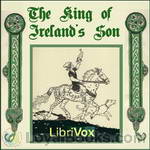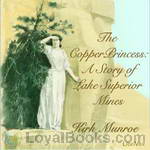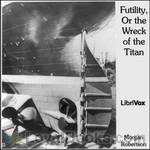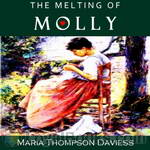|
Books Should Be Free Loyal Books Free Public Domain Audiobooks & eBook Downloads |
|
|
Books Should Be Free Loyal Books Free Public Domain Audiobooks & eBook Downloads |
|
Fiction |
|---|
|
Book type:
Sort by:
View by:
|
By: Padraic Colum (1881-1972) | |
|---|---|
 The King of Ireland's Son
The King of Ireland's Son
The King of Ireland's Son is a children's novel published in Ireland in 1916 written by Padraic Colum, and illustrated by Willy Pogany. It is the story of the eldest of the King of Ireland's sons, and his adventures winning and then finding Fedelma, the Enchanter's Daughter, who after being won is kidnapped from him by the King of the Land of Mist. It is solidly based in Irish folklore, itself being originally a folktale. (Introduction by Wikipedia) | |
By: Ben Bova (1932-) | |
|---|---|
 The Dueling Machine
The Dueling Machine
The Dueling Machine is the solution to settling disputes without injury. After you and your opponent select weapons and environments you are injected into an artificial reality where you fight to the virtual death… but no one actually gets hurt. That is, until a warrior from the Kerak Empire figures a way to execute real-world killings from within the machine. Now its inventor Dr. Leoh has to prevent his machine from becoming a tool of conquest. – The Dueling Machine, written with Myron R. Lewis, first appeared in the May, 1963 issue of Analog Science Fact & Fiction. | |
By: E. E. “Doc” Smith (1890-1965) | |
|---|---|
 Triplanetary, First in the Lensman Series
Triplanetary, First in the Lensman Series
Triplanetary was first serialized in Amazing Stories in 1934. After the Lensman series became popular, Smith took his Triplanetary story and turned it into the first of the Lensman series, using it as a prequel to give the back story for the protaganists in the Lensmen series. He added 6 new chapters, doubling it in size and it's really a different book from the serialized novel, being published 14 years after the first. It was put into Gutenberg just last year. The novel covers several episodes in an eons-long eugenics project of the super-intelligences of the Arisia... | |
By: E. E. Smith (1890-1965) | |
|---|---|
 Subspace Survivors
Subspace Survivors
A team of space travelers are caught in a subspace accident which, up to now, no one has ever survived. But some of the survivors of the Procyon are not ordinary travelers. Their psi abilities allow them to see things before they happen. But will it be enough?Smith's story "Subspace Survivors" first appeared in the July 1960 issue of the magazine Astounding. | |
 Galaxy Primes
Galaxy Primes
They were four of the greatest minds in the Universe: Two men, two women, lost in an experimental spaceship billions of parsecs from home. And as they mentally charted the Cosmos to find their way back to earth, their own loves and hates were as startling as the worlds they encountered. | |
By: Marshall Saunders (1861-1947) | |
|---|---|
 Beautiful Joe
Beautiful Joe
Beautiful Joe is a real dog, and “Beautiful Joe” is his real name. He belonged during the first part of his life to a cruel master, who mutilated him in the manner described in the story. He was rescued from him, and is now living in a happy home with pleasant surroundings, and enjoys a wide local celebrity.The character of Laura is drawn from life, and to the smallest detail is truthfully depicted. The Morris family has its counterparts in real life, and nearly all of the incidents of the story are founded on fact. | |
By: George Meredith (1828-1909) | |
|---|---|
 The Egoist
The Egoist
The Egoist is a tragicomical novel by George Meredith published in 1879. The novel recounts the story of self-absorbed Sir Willoughby Patterne and his attempts at marriage; jilted by his first bride-to-be, he vacillates between the sentimental Laetitia Dale and the strong-willed Clara Middleton. More importantly, the novel follows Clara’s attempts to escape from her engagement to Sir Willoughby, who desires women to serve as a mirror for him and consequently cannot understand why she would not want to marry him... | |
 The Shaving of Shagpat
The Shaving of Shagpat
The novel is a humorous oriental romance and allegory written in the style of the Arabian Nights. Like its model, it includes a number of stories within the story, along with poetic asides.“The variety of scenes and images, the untiring evolution of plot, the kaleidoscopic shifting of harmonious colours, all these seem of the very essence of Arabia, and to coil directly from some bottle of a genie. Ah! what a bottle!” -Edmund Gosse in Gossip in a Library | |
By: Peter B. Kyne (1880-1957) | |
|---|---|
 The Go-Getter
The Go-Getter
A disabled veteran succeeds as a civilian with persistence and military focus. | |
By: Thomas Nelson Page | |
|---|---|
 Santa Claus's Partner
Santa Claus's Partner
Livingstone has reached a pinnacle in his life. He is finally worth 7 figures, yet his bottom line requires that he cut back on charities this year at Christmas time. Business is business, after all. But success makes him surly and his accomplishment soon feels anti-climatic. Regrets plague him. Can he rediscover the joy of life with the help of Santa Claus’s Partner? | |
By: Edith Nesbit (1858-1924) | |
|---|---|
 Pussy and Doggy Tales
Pussy and Doggy Tales
Charming Tales about cats and dogs. | |
 Story of the Amulet
Story of the Amulet
The third of the series featuring Cyril, Anthea, Robert and Jane: four children who are, as they often say, "the sort of people that wonderful things happen to". In 'Five Children and It' they were lucky enough to meet the magical, wish-granting Psammead - and in this final book they meet him once again. He guides them to an ancient Amulet that will help them find their hearts' desire - but it's only half an amulet, and seeking for the other half has them whizzing about through time on another series of amazing adventures. | |
By: Somerset Maugham | |
|---|---|
 Of Human Bondage
Of Human Bondage
Of Human Bondage, published in 1915, is considered to be W. Somerset Maugham’s best work. Many believe the novel to be one of the world’s literary masterpieces. The story follows Phillip Carey from early childhood through his 30’s. Orphaned at 9, Phillip spends his early years raised by his childless aunt and uncle. His aunt tries to be a mother to Philip, but she is unsure how to behave whereas his uncle, a vicar, takes a cold disposition towards him. Philip is sent to a boarding school but his shyness and his club foot make it difficult for him to fit in... | |
By: Alice Hale Burnett | |
|---|---|
 Christmas Holidays at Merryvale
Christmas Holidays at Merryvale
“Toad” Brown, his brother, and their friends have a jolly time at the Christmas holidays. They daydream at a toyshop window, chop down a Christmas tree in the woods, have a grand snowball fight, and plan a surprise for a friend in this tale of early 20th-century small-town life. Published in 1916, this short book is perfect for younger readers and listeners. Read along and see the charming illustrations. | |
By: Poul Anderson (1926-2001) | |
|---|---|
 Security
Security
“Security”, tells the story of a compartmentalized government physicist ordered by secret police to complete experiments aimed at developing a new weapon. He is brought to a hidden space station and put in charge of the project but there are many questions. In a world of spies watching spies it’s sometimes hard to know what’s patriotic. -- Poul Anderson was a Golden Age Science Fiction and Fantasy author. “Security” first appeared in the magazine “Space Science Fiction” in February of 1953 | |
By: Edmund Gosse | |
|---|---|
 Gossip in a Library
Gossip in a Library
A collection of informal essays about books in his library. He combines commentary, translations, and humorous asides about authors and their subjects. | |
By: Jane Porter (1776-1850) | |
|---|---|
 The Scottish Chiefs
The Scottish Chiefs
An adventure novel about William Wallace, one of the most popular books ever written by Jane Porter. The French version was even banned by Napoleon, and the book has remained very popular with Scottish children, but is equally enjoyable for adults. | |
By: Bliss Perry (1860-1954) | |
|---|---|
 Fishing with a Worm
Fishing with a Worm
Fishing with a Worm by Bliss Perry includes the poignant and philisophical observations of a fly fisherman lured by the worm. Bliss Perry was a professor of literature at Princeton and Harvard Universities and spent time in Vermont writing and fly fishing. | |
By: Sarah S. Baker (1824-1906) | |
|---|---|
 Aunt Friendly's Picture Book
Aunt Friendly's Picture Book
This book includes the classic alphabet, Sing-A-Song Of Sixpence, The Frog Who Would A Wooing Go, The Three Little Pigs, Puss In Boots, and The Ugly Duckling. Fun for all ages! | |
By: Amy Levy (1861-1889) | |
|---|---|
 Reuben Sachs
Reuben Sachs
Reuben Sachs is a London lawyer whose political aspirations do not include marriage to Judith Quixano, the daughter of a respectable but unexceptional family. But without Reuben, a woman like Judith might have a bleak future in mid-19th century England: a loveless marriage or lifelong dependency are apparently her only options… A feminist, a Jew, and a lesbian, Amy Levy wrote about Anglo-Jewish cultural mores and the lives of would-be independent women in Victorian society. Levy was as repelled by contemporary literature’s occasional paragon (e... | |
By: Hartwell James | |
|---|---|
 The Enchanted Castle: Fairy Tales from Flowerland
The Enchanted Castle: Fairy Tales from Flowerland
Every boy and girl—and for that matter every man and woman, too—rejoices when the winter snows have vanished and the earth once more puts on her beautiful dress of green, for then the flowers wake from their sleep and clothe the earth with beauty. Because all boys and girls love flowers, those of them who read this book will be interested in the beautiful stories they have to tell, loving them even more when they know something of their past history and some of the events with which they are associated. | |
By: Kirk Munroe (1850-1930) | |
|---|---|
 The Copper Princess: A Story of Lake Superior Mines
The Copper Princess: A Story of Lake Superior Mines
The Copper Princess: A Story of Lake Superior Mines is an adventure set in the beautiful Upper Peninsula of Michigan. The delightful story features a brave and wholesome hero struggling for his rightful copper mining inheritance against smugglers and bandits. He also encounters a beautiful and mysterious maiden who is caught in her father’s secret crimes. | |
By: Joan Conquest | |
|---|---|
 The Hawk of Egypt
The Hawk of Egypt
A tragic love triangle between a beautiful English girl, an English gentleman, and a half-English, half-Egyptian plays out among the ruins and under the desert stars of 1920s era Egypt. The saga ends, as all love triangles must, in tragedy upon the desert sands. | |
By: Victor Appleton | |
|---|---|
 Tom Swift and his Airship
Tom Swift and his Airship
In Tom Swift and His Airship, Tom Swift has finished his latest invention- the Red Cloud, a fast and innovative airship. Tom is anxious for a cross-country trial, but just before he and his friends take off, the Shopton bank is robbed. No sooner is Tom in the air than he is blamed for the robbery. Suddenly, he's a wanted fugitive but doesn't know why until he's half-way across the country. With no safe harbor or friend on the land below, Tom must race back to Shopton to clear his name before he's shot out of the sky. | |
 Tom Swift Among the Diamond Makers
Tom Swift Among the Diamond Makers
Tom Swift flies his airship to the mountain tops of Colorado to seek for the secret of the Diamond Makers: criminal scientists who have figured out the formula of manufacturing a limitless fortune in diamonds. But these rogues will stop at nothing to keep their secret. Tom & friends are soon captured and left to die in a collapsing mountain. | |
 Tom Swift and His Wireless Message
Tom Swift and His Wireless Message
Tom Swift & friends decide to trial an experimental airship near the New Jersey coast, and are unexpectedly swept out to sea by hurricane winds. Unable to steer or navigate without tearing the airship apart, the hapless crew must simply let the storm take them wherever it will. Unfortunately, the storm proves too much for the craft and Tom makes a crash landing on the uninhabited and crumbling Earthquake Island. | |
 Tom Swift and His Sky Racer
Tom Swift and His Sky Racer
A $10,000 prize lures Tom into competing at a local aviation meet at Eagle Park. Tom is determined to build the fastest plane around, but his plans mysteriously disappear, which means Tom must redesign his new airplane from the beginning. | |
By: Ray Cummings (1887-1957) | |
|---|---|
 Brigands of the Moon
Brigands of the Moon
Gregg Haljan was aware that there was a certain danger in having the giant spaceship Planetara stop off at the moon to pick up Grantline’s special cargo of moon ore. For that rare metal — invaluable in keeping Earth’s technology running — was the target of many greedy eyes. But nevertheless he hadn’t figured on the special twist the clever Martian brigands would use. So when he found both the ship and himself suddenly in their hands, he knew that there was only one way in which he could hope to save that cargo and his own secret — that would be by turning space-pirate himself and paying the Brigands of the Moon back in their own interplanetary coin. (From the Gutenberg e-text) | |
By: Kate Langley Bosher (1865-1932) | |
|---|---|
 Mary Cary, Frequently Martha
Mary Cary, Frequently Martha
“My name is Mary Cary. I live in the Yorkburg Female Orphan Asylum. You may think nothing happens in an Orphan Asylum. It does. The orphans are sure enough children, and real much like the kind that have Mothers and Fathers; and that’s why I am going to write this story.” So begins Mary’s diary, which she fills with her various doings and misadventures at the Asylum in Virginia and her sharp observations about life and human nature. She loathes Miss Bray, the head of the Asylum, who is not above telling bald-faced lies to the Board to further her own selfish ends... | |
 People Like That
People Like That
A single woman from a family that is well-off, buys a house at a place that is looked down upon and disapproved by her family and friends alike. Her reason - she wants to live the life of and know people like that. (This book's got one of the cutest romantic endings I've ever read). What is surprising is this book is in the PD - there are quite a few modern expressions and comparatively less quaint, out-of-fashion expressions. | |
By: Edward Phillips Oppenheim | |
|---|---|
 The Zeppelin's Passenger
The Zeppelin's Passenger
The Zeppelin’s Passenger is a tale of German espionage in England during World War I. Dreymarsh is a fictional “backwater” area in England with no apparent military value. The story begins with Dreymarsh residents discovering an observation car from a German zeppelin along with a Homburg hat near Dreymarsh. The mystery is further complicated when an Englishman, Mr. Hamar Lessingham, presents himself at Mainsail Haul which is the residence of Sir Henry Cranston. Lessingham bears with him, hand-carried letters from Major Richard Halstead, and a British prisoner of war in Germany... | |
 The Great Impersonation
The Great Impersonation
E. Phillips Oppenheim, an English novelist created well in excess of 100 novels and 30 plus collections of short stories. Most of his tales are thrillers and espionage. The Great Impersonation was written following World War I and is considered by many to be perhaps his best novel. The story focuses on German espionage in England prior to the start of World War I. The tale centers on two characters that are almost identical in appearance. Indeed, while both attend the same school in England, they are often mistaken for one another... | |
By: Morgan Robertson | |
|---|---|
 Futility, Or the Wreck of the Titan
Futility, Or the Wreck of the Titan
This novel was published a full 14 years before the sinking of the Titanic, but listeners may be surprised at how many parallels this fictional tale has with subsequent true events. The Titan is the largest and most technologically advanced steamship of her time. She is considered unsinkable. Her full speed crossings of the Northern Lane Route carry her rich passengers in the highest standards of luxury and comfort. The less well-off travel in rougher quarters but still benefit from the speed of travel... | |
By: Jennie Hall (1875-1921) | |
|---|---|
 Viking Tales
Viking Tales
Viking tales are tales from Iceland, featuring the king Halfdan and his son Harald. | |
By: Knut Hamsun (1859-1952) | |
|---|---|
 Hunger
Hunger
Hunger (Norwegian: Sult) is a novel by the Norwegian author and Nobel Prize winner Knut Hamsun and was published in its final form in 1890. The novel has been hailed as the literary opening of the 20th century and an outstanding example of modern, psychology-driven literature. It hails the irrationality of the human mind in an intriguing and sometimes humorous novel. Written after Hamsun's return from an ill-fated tour of America, Hunger is loosely based on the author's own impoverished life before his breakthrough in 1890... | |
 Growth of the Soil
Growth of the Soil
Growth of the Soil (Markens Grøde) is the novel by Norwegian writer Knut Hamsun which won him the Nobel Prize in Literature in 1920. The essential elements of this novel are expressed in the words of the English translator W.W. Worster in his footnote in December 1920: 'It is the life story of a man in the wilds, the genesis and gradual development of a homestead, the unit of humanity, in the unfilled, uncleared tracts that still remain in the Norwegian Highlands. It is an epic of earth; the history of a microcosm... | |
By: Ida Coe and Alice Christie (1876-?) | |
|---|---|
 Story Hour Readers: Third Year
Story Hour Readers: Third Year
Short and sweet stories for children from the 19th century. The stories were compiled by two New York City teachers and were thought appropriate for third year children at that time. | |
By: Maria Thompson Daviess (1872-1924) | |
|---|---|
 The Melting of Molly
The Melting of Molly
Meet Molly: a quirky, spirited twenty-five-year old, widowed for 6 years, living in picturesque Hillsboro with her aunt amidst gossipy neighbors, on a strict diet, and in serious boy trouble. There’s Arthur, her childhood sweetheart; then, there’s the enigmatic, charming Judge Wade; and of course, there’s her cousin Tom; and then, her infuriating neighbor, John Moore… But who will melt her heart? It is Arthur’s return, and his seemingly simple request of wanting to see her in the same blue dress she wore when he left, that throws everything into turmoil… Sometimes, one can only find some solace in one’s garden... | |
By: Maria Thompson Daviess (1872-1924) | |
|---|---|
 Heart's Kingdom
Heart's Kingdom
Nickols Powers is in love with the beautiful Charlotte and desperate to marry her. Charlotte however, is independent and reluctant to accept his religious views as a good wife should. However, she may still be convinced by the charismatic preacher building a new church in her own backyard. | |
By: John Luther Long (1861-1927) | |
|---|---|
 Madame Butterfly
Madame Butterfly
Madame Butterfly is the story of the young Japanese girl Cho-Cho San, who marries a flighty American naval officer, and is thenceforth outcast from her relatives. Anxiously she awaits the return of her beloved husband, but when he finally anchors in the harbour, Cho-Cho San does not get the happy ending she was hoping for. This short story by John Luther Long has inspired Giacomo Puccini to write the opera of the same name. (Introduction by Availle) | |
By: Cecil Henry Bompas | |
|---|---|
 Folklore of the Santal Parganas
Folklore of the Santal Parganas
This is an intriguing collection of folklore from the Santal Parganas, a district in India located about 150 miles from Calcutta. As its Preface implies, this collection is intended to give an unadulterated view of a culture through its folklore. It contains a variety of stories about different aspects of life, including family and marriage, religion, and work. In this first volume, taken from Part I, each story is centered around a particular human character. These range from the charmingly clever (as in the character, The Oilman, in the story, “The Oilman and His Sons”) to the tragically comical (as in the character, Jhore, in the story “Bajun and Jhore”)... | |
By: Robert Michael Ballantyne (1825-1894) | |
|---|---|
 Gorilla Hunters
Gorilla Hunters
Ralph Rover is happily at home from his adventure on The Coral Island and wondering if he should settle down when he receives a visit from an eccentric stranger that won't give his name. This visit starts him on a string of adventures that find him getting charged by rhinoceroses, chased by African natives, and facing down a larger-than-life gorilla on his own. Of course, this is only the start of his adventure in to the land of the gorillas. Please note: this book has some words now considered derogatory, which are used in a generic way without any derogatory meaning... | |
 Iron Horse
Iron Horse
“Is that your bundle, sir?” repeated Mr Blunt a little louder. “Eh? yes, yes—all right,” replied Edwin, annoyed at the interruption, and thinking only of Emma Lee, to whom he turned, and went on—“Well, when Colonel Jones had scaled the first wall—” “Come, sir,” said Blunt, entering the carriage, and laying his hand on Edwin’s shoulder, “it’s not all right. This is another man’s property.” The youth turned round indignantly, and, with a flushed countenance, said, “What do you mean?” “I mean that you are travelling with another man’s property,” said Blunt, quietly pointing to the strapped rug... | |
 Charlie to the Rescue
Charlie to the Rescue
Charlie Brooke is always rescuing others, and sometimes even himself! His latest rescue, though, could turn out to be fatal... | |
 Post Haste
Post Haste
In this book, Ballantyne weaves the story of Phillip Mayland and his friend, George Aspel with an interesting portrayal of the British Post Office as it existed in the 19th century. In the words of R. M. Ballantyne himself: "This tale is founded chiefly on facts furnished by the Postmaster-General’s Annual Reports, and gathered, during personal intercourse and investigation, at the General Post-Office of London and its Branches. It is intended to illustrate—not by any means to exhaust—the subject of postal work, communication, and incident throughout the Kingdom... | |
 Island Queen
Island Queen
The story of Dominic, Otto and Pauline Rigonda, three siblings who are blown onto an island after being shipwrecked, and are later joined by the immigrant passengers and crew of a ship that is wrecked on the same island. When the question of government comes up, the little colony chooses a queen, and they work on improving the island for some time, despite internal dissensions, and an attack by savages. But eventually the colony encounters natural forces it cannot resist, and the queen and her family return to England, hopefully to live "happily ever after". | |
 Jarwin and Cuffy
Jarwin and Cuffy
Jarwin is an English sailor who has been shipwrecked. He is stranded on a raft with only his dog Cuffy, and land is nowhere in sight. Their food and water is running out. What can Jarwin do to save his dog's (and his own) life? | |
 Fighting the Flames
Fighting the Flames
| |
 Twice Bought
Twice Bought
This story is set in the gold fields of Oregon, where Tom Brixton, and his best friend, Fred Westly, are digging gold to try to “make their pile”. Before leaving England, the steady and God-fearing Fred had promised Tom's mother that he would do his best to take care of his friend, but in spite of all his efforts, Tom had fallen in with bad companions and taken to gambling. He was convinced that he could make his fortune quicker by attempting to increase it at the dice or card table, and all his friend's attempts to make him see his errors were unavailing... | |
By: Johnston McCulley (1883-1958) | |
|---|---|
 The Black Star
The Black Star
The Black Star was a master criminal who took great care to never be identifiable, always wore a mask so nobody knew what he looked like, rarely spoke to keep his voice from being recognized, and the only mark left at the scenes of the crimes which he and his gang committed were small black stars which were tacked as a sign of their presence, and an occasional sarcastic note to signify his presence and responsibility. Even those who worked for him knew nothing of him, all of which were making his crimes virtually unsolvable... | |
 The Curse of Capistrano
The Curse of Capistrano
The Curse of Capistrano by Johnston McCulley is the first work to feature the fictional character Zorro (zorro is the Spanish word for fox). The story was later republished under the name The Mark of Zorro. Senor Zorro is deemed an outlaw as he fights those in authority while seeking justice for the oppressed. He also woos and captures the heart of the lovely Senorita Lolita, but her father would see her married to the rich Don Diego Vega. Meanwhile, the ever persistent Sgt. Gonzales is closing in on our lovers and would means to see the end of Senor Zorro. | |
By: Goldsworthy Lowes Dickinson (1862-1932) | |
|---|---|
 The Greek View of Life
The Greek View of Life
“With the Greek civilisation beauty perished from the world. Never again has it been possible for man to believe that harmony is in fact the truth of all existence.”This elegantly-written work provides a splendid introduction to the Greeks of the classic period: how they thought, wrote, and organised their lives and loves. Although it dates from the 1890s, there is very little about it that has dated. To its author’s credit, the subject of “Greek love” is dealt with in a sane and factual context - despite the judicial assassination of Oscar Wilde going on in the background... | |
By: Antonio Colmenero de Ledesma (d. 17th century) | |
|---|---|
 Chocolate: or, An Indian Drinke
Chocolate: or, An Indian Drinke
The Author sings the praises of Chocolate. “By the wise and Moderate use whereof, Health is preserved, Sicknesse Diverted, and Cured, especially the Plague of the Guts; vulgarly called _The New Disease_; Fluxes, Consumptions, & Coughs of the Lungs, with sundry other desperate Diseases. By it also, Conception is Caused, the Birth Hastened and facilitated, Beauty Gain’d and continued.” | |
By: Johnny Gruelle (1880-1938) | |
|---|---|
 Raggedy Andy Stories
Raggedy Andy Stories
Raggedy Ann is a fictional character created by writer Johnny Gruelle (1880–1938) in a series of books he wrote and illustrated for young children. Raggedy Ann is a rag doll with red yarn for hair. The character was created in 1915 as a doll, and was introduced to the public in the 1918 book Raggedy Ann Stories. A doll was also marketed along with the book to great success. A sequel, Raggedy Andy Stories (1920) introduced the character of her brother, Raggedy Andy, dressed in sailor suit and hat. | |
By: Friedrich de La Motte-Fouqué (1777-1843) | |
|---|---|
 Undine
Undine
Undine is a novel by Friedrich de la Motte Fouqué concerning Undine, a water spirit who marries a Knight named Huldebrand in order to gain a soul. It is an early German romance, which has been translated into English and other languages. The novel served as inspiration for two operas in the romantic style by Ernst Theodor Amadeus Hoffmann and Albert Lortzing, respectively, and two ballets: the nineteenth century Ondine and the twentieth century Undine. An edition of the book was illustrated by Arthur Rackham... | |
By: Howard R. Garis (1873-1962) | |
|---|---|
 Sammie and Susie Littletail
Sammie and Susie Littletail
Once upon a time there lived in a small house built underneath the ground two curious little folk, with their father, their mother, their uncle and Jane Fuzzy-Wuzzy. Jane Fuzzy-Wuzzy was the nurse, hired girl and cook, all in one, and the reason she had such a funny name was because she was a funny cook. She had long hair, a sharp nose, a very long tail and the brightest eyes you ever saw. She could stay under water a long time, and was a fine swimmer. In fact, Jane Fuzzy-Wuzzy was a big muskrat, and the family she worked for was almost as strange as she was. (excerpt from text) | |
 Rick and Ruddy
Rick and Ruddy
This delightful story is full of ups and downs involving a young boy and his dog, "a gift from the sea". The adventures range from playful antics to times of peril, and through it all, our protagonists (both human and canine alike) come through for each other as only a dog and his boy can! This adventurous and fun tale will bring you back to your own childhood memories...you and that special tail-wagger from the "good ol' days". | |
By: Rex Stout | |
|---|---|
 Under the Andes
Under the Andes
Under the Andes was written by Rex Stout years before his creation of the immensely popular Nero Wolfe series of novels, and while perhaps his future writing style is still blossoming, certainly his knack for weaving a fantastic tale of mystery and adventure will have most readers anxious for the next phase of adventure at every turn. The story finds two brothers and a pretty female companion on a journey which eventually takes them to a series of underground caves under the Andes of South America, where they encounter a lost tribe of Incas who have apparently survived hundreds of years oblivious of the outside world... | |
By: James Blish (1921-1975) | |
|---|---|
 The Thing in the Attic
The Thing in the Attic
Honath the Pursemaker is a heretic. He doesn’t believe the stories in the Book of Laws which claims giants created his tree-dwelling race. He makes his opinion known and is banished with his infidel friends to the floor of the jungle where dangers abound. Perhaps he’ll find some truth down there. – The Thing in the Attic is one of Blish’s Pantropy tales and was first published in the July, 1954 edition of If, Worlds of Science Fiction magazine. | |
By: Frederik Pohl | |
|---|---|
 The Knights of Arthur
The Knights of Arthur
Sailors Sam Dunlap and Arthur check in to a New York hotel to await their mate Vern Engdahl when a girl shows up proposing to purchase Arthur. They need guys like Arthur to help run the city, and the fact that he fits in a small suitcase is even better. – The Knights of Arthur was first published in the January 1958 edition of Galaxy Science Fiction magazine. | |